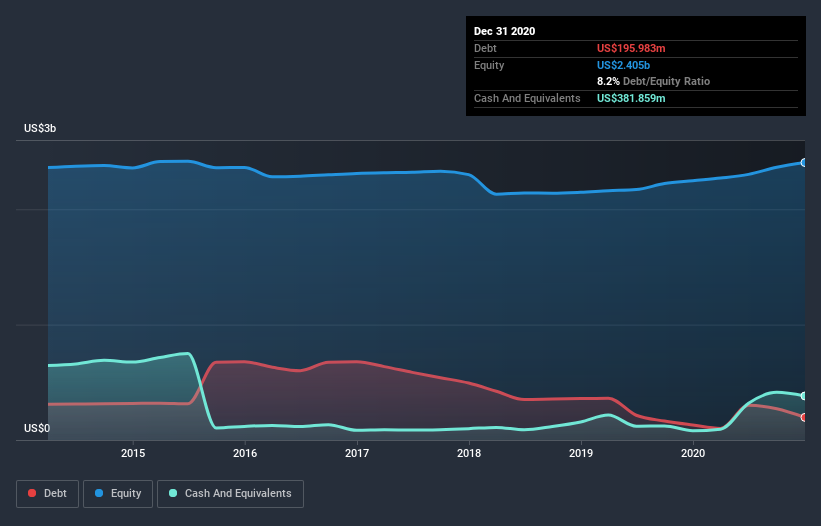
Legendary fund manager Li Lu (who Charlie Munger backed) once said, 'The biggest investment risk is not the volatility of prices, but whether you will suffer a permanent loss of capital.' When we think about how risky a company is, we always like to look at its use of debt, since debt overload can lead to ruin. We note that Royal Gold, Inc. (NASDAQ:RGLD) does have debt on its balance sheet. But is this debt a concern to shareholders?
When Is Debt A Problem?
Generally speaking, debt only becomes a real problem when a company can't easily pay it off, either by raising capital or with its own cash flow. If things get really bad, the lenders can take control of the business. However, a more usual (but still expensive) situation is where a company must dilute shareholders at a cheap share price simply to get debt under control. Of course, plenty of companies use debt to fund growth, without any negative consequences. When we think about a company's use of debt, we first look at cash and debt together.
See our latest analysis for Royal Gold
How Much Debt Does Royal Gold Carry?
You can click the graphic below for the historical numbers, but it shows that as of December 2020 Royal Gold had US$196.0m of debt, an increase on US$129.9m, over one year. However, it does have US$381.9m in cash offsetting this, leading to net cash of US$185.9m.

A Look At Royal Gold's Liabilities
According to the last reported balance sheet, Royal Gold had liabilities of US$57.2m due within 12 months, and liabilities of US$301.9m due beyond 12 months. Offsetting these obligations, it had cash of US$381.9m as well as receivables valued at US$53.3m due within 12 months. So it can boast US$76.1m more liquid assets than total liabilities.
This state of affairs indicates that Royal Gold's balance sheet looks quite solid, as its total liabilities are just about equal to its liquid assets. So it's very unlikely that the US$7.06b company is short on cash, but still worth keeping an eye on the balance sheet. Simply put, the fact that Royal Gold has more cash than debt is arguably a good indication that it can manage its debt safely.
In addition to that, we're happy to report that Royal Gold has boosted its EBIT by 31%, thus reducing the spectre of future debt repayments. There's no doubt that we learn most about debt from the balance sheet. But it is future earnings, more than anything, that will determine Royal Gold's ability to maintain a healthy balance sheet going forward. So if you're focused on the future you can check out this free report showing analyst profit forecasts.
But our final consideration is also important, because a company cannot pay debt with paper profits; it needs cold hard cash. Royal Gold may have net cash on the balance sheet, but it is still interesting to look at how well the business converts its earnings before interest and tax (EBIT) to free cash flow, because that will influence both its need for, and its capacity to manage debt. Happily for any shareholders, Royal Gold actually produced more free cash flow than EBIT over the last two years. That sort of strong cash conversion gets us as excited as the crowd when the beat drops at a Daft Punk concert.
Summing up
While we empathize with investors who find debt concerning, you should keep in mind that Royal Gold has net cash of US$185.9m, as well as more liquid assets than liabilities. The cherry on top was that in converted 111% of that EBIT to free cash flow, bringing in US$253m. So we don't think Royal Gold's use of debt is risky. The balance sheet is clearly the area to focus on when you are analysing debt. But ultimately, every company can contain risks that exist outside of the balance sheet. Case in point: We've spotted 2 warning signs for Royal Gold you should be aware of, and 1 of them can't be ignored.
At the end of the day, it's often better to focus on companies that are free from net debt. You can access our special list of such companies (all with a track record of profit growth). It's free.
If you decide to trade Royal Gold, use the lowest-cost* platform that is rated #1 Overall by Barron’s, Interactive Brokers. Trade stocks, options, futures, forex, bonds and funds on 135 markets, all from a single integrated account. Promoted
New: AI Stock Screener & Alerts
Our new AI Stock Screener scans the market every day to uncover opportunities.
• Dividend Powerhouses (3%+ Yield)
• Undervalued Small Caps with Insider Buying
• High growth Tech and AI Companies
Or build your own from over 50 metrics.
This article by Simply Wall St is general in nature. It does not constitute a recommendation to buy or sell any stock, and does not take account of your objectives, or your financial situation. We aim to bring you long-term focused analysis driven by fundamental data. Note that our analysis may not factor in the latest price-sensitive company announcements or qualitative material. Simply Wall St has no position in any stocks mentioned.
*Interactive Brokers Rated Lowest Cost Broker by StockBrokers.com Annual Online Review 2020
Have feedback on this article? Concerned about the content? Get in touch with us directly. Alternatively, email editorial-team (at) simplywallst.com.
About NasdaqGS:RGLD
Royal Gold
Acquires and manages precious metal streams, royalties, and related interests.
Flawless balance sheet with solid track record and pays a dividend.


